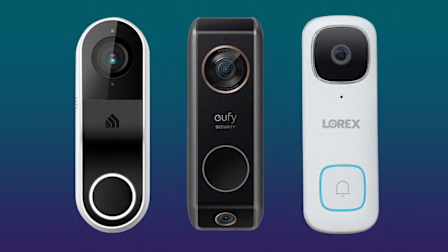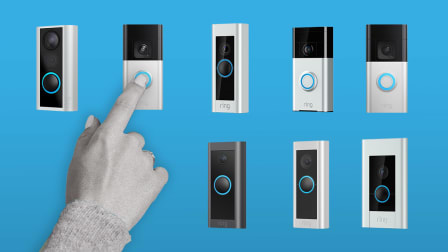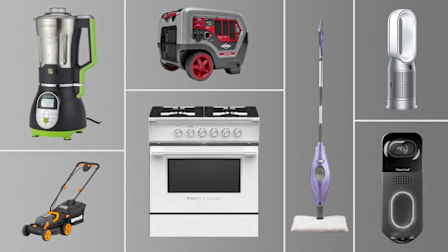Best Google Nest and Ring Video Doorbell Alternatives
Your options include top-scoring models from CR’s tests made by Arlo, Eufy, Logitech, Lorex, Netatmo, and SimpliSafe
When you shop through retailer links on our site, we may earn affiliate commissions. 100% of the fees we collect are used to support our nonprofit mission. Learn more.

When you think of video doorbells, also known as doorbell cameras, Google Nest and Amazon’s Ring might come to mind. Those two brands make some of the most popular video doorbells you can buy.
But given privacy concerns, you might wonder about options from other companies.
“When you use a Google Nest or Ring video doorbell, they upload footage to Google’s and Amazon’s servers,” says Justin Brookman, director of privacy and technology policy for Consumer Reports. “Given the growing concerns over how Google and Amazon use the data they collect, consumers might not feel comfortable trusting these companies.”
Ring has been at the center of complaints from privacy and civil rights advocates, who argue that the company’s police partnerships harm communities of color and jeopardize consumer privacy. To address those concerns, the company has made a number of changes over the past few years, such as creating a privacy and security dashboard for users to customize settings, allowing end-to-end encryption for select Ring cameras, limiting how the police can request camera footage, and conducting a two-year outside audit that brought about changes to Ring’s police partnerships and neighborhood watch social network. But privacy and civil rights groups say the changes aren’t enough.
What’s more, in a few years you might not need a Nest or Ring doorbell camera to take full advantage of the rich features provided by the Amazon and Google ecosystems. Both Amazon and Google are part of the Matter smart home standard, which will make it easier for devices to work together and take advantage of a host of smart home ecosystems, including Apple Home and Samsung SmartThings, simultaneously. (The standard doesn’t currently support video doorbells or cameras, but they’re expected to come into the fold in a future version.)
At Consumer Reports we test video doorbells from more than 30 brands. Below you’ll find the six best Google Nest and Ring doorbell alternatives from our video doorbell ratings. The list is arranged in alphabetical, not rank, order. CR members can click on each video doorbell’s name for detailed ratings and reviews.
For advice on what to look for in a video doorbell, check out our home security camera buying guide. No matter which model you choose, read our guide on how to prevent security cameras from being hacked. And learn about how CR’s tests revealed security vulnerabilities in video doorbells.
Free video storage: Yes, using 8 gigabytes of built-in memory (Eufy estimates it will store up to 90 days of motion-triggered video clips).
Optional storage plans: Through a Eufy Security storage plan, you get 30 days of cloud storage for one camera for $3 per month or 30 days for up to 10 cameras for $10 per month.
CR’s take: The Eufy Video Doorbell 2K Dual (Wired) is one of a few video doorbells with two cameras, one pointed straight out to spot visitors (or intruders) and one pointed down to keep an eye on package deliveries. In our lab tests, it receives strong scores for video quality, data security, and response time. It offers a decent amount of smart features and its data privacy is middling, which is actually better than many competing doorbells.
In addition to its two cameras, this Eufy features HDR video, monitoring zones, three-second video previews (to show what happened before the camera detected motion), facial recognition, person detection, and package detection. Notably, the last three features don’t require a subscription, which is common for other doorbells.
The Eufy doorbell features 8 gigabytes of built-in memory to store footage, but the company also offers cloud video storage subscriptions. You can get 30 days of cloud storage for one camera for $3 per month (or $30 per year), or 30 days for up to 10 cameras for $10 per month (or $100 per year). As its name suggests, the Eufy Video Doorbell 2K Dual (Wired) requires low-voltage doorbell wiring for power, but can’t ring your home’s existing chime. Instead, it comes with a wireless, plug-in chime in the box.
If you’re interested in this doorbell, but need a battery-powered model, check out the Eufy Video Doorbell 2K Dual (Battery). It does well overall in our tests, but its video quality and response time aren’t as good when compared with the wired version.
A word about Eufy’s digital privacy and security: In November 2022, Eufy had a security issue where camera feeds could be accessed with a media player. The company claims to have fixed it, but our test engineers are looking into the issue. We’ll update this story if we learn more. This follows a May 2021 security problem where Eufy users were accidentally able to access cameras owned by other users. The company said at the time that it was working to put additional safeguards in place to prevent such issues from happening again.
Free video storage: None.
Optional storage plans: Requires an Apple iCloud plan for 10 days of storage for one camera at $1 per month, for up to five cameras at $3 per month, or for unlimited cameras at $10 per month.
CR’s take: The Logitech Circle View Doorbell is unusual in that it only works with a special feature of the Apple Home smart home system called HomeKit Secure Video. Through this software, it uses end-to-end encryption to keep your video secure. As a result of this tight-knit integration, the Logitech doorbell only works with iPhones (sorry, Android users), stores your videos only in Apple iCloud (if you pay for a storage plan), and requires an Apple home hub (either a HomePod smart speaker or an Apple TV streaming box) to process motion alerts for people, animals, and vehicles. In fact, there’s no Logitech app for the doorbell; it uses the Apple Home app instead.
But if you’re a big fan of Apple products, this doorbell will work quite well for you. In our tests, it earns high marks for video quality and offers great data security and speedy response time for alerts and loading live feeds. Its only flaws are that its data privacy isn’t very good and it doesn’t offer as many smart features as other top-rated options. Other features include monitoring zones, facial recognition, a night light for color night vision, and high dynamic range (HDR) video for more vivid video.
For 10 days of cloud video storage for one camera, you’ll need to subscribe to a 50GB iCloud storage plan at $1 per month. For up to five cameras, you’ll need a 200GB iCloud plan at $3 per month. For an unlimited number of cameras, you’ll need a 2TB iCloud plan at $10 per month. The Logitech Circle View Doorbell requires low-voltage doorbell wiring for power and can ring your home’s existing doorbell chime.
Free video storage: Yes, using the included 16GB microSD card.
Optional storage plans: Not available.
CR’s take: The Lorex LNWDB1 1080P WiFi Video Doorbell is one of the more affordable options on this list, and it offers performance on a par with some doorbells that cost significantly more. In our tests, it offers great data security and earns a middle-of-the-road score for data privacy. It also offers superb video quality and response time, as well as a decent array of smart features. They include monitoring zones, geofencing (this feature uses your phone’s location to receive alerts when you’re home), and voice control via Amazon Alexa and Google Assistant.
This Lorex model stores footage locally on a 16GB microSD card that comes with the doorbell. If you want to store even more footage, the doorbell supports up to a 64GB microSD card. It also requires low-voltage doorbell wiring for power and can ring your home’s existing doorbell chime.
If you’re willing to spend a bit more, you might also want to consider the Lorex 2K QHD B451AJD-E. It performs identically to this Lorex 1080p model in our tests, but adds color night vision and high dynamic range to the mix.
Free video storage: Yes, using the 8GB microSD card (included).
Optional storage plans: Not available.
CR’s take: The Netatmo Smart Video Doorbell is one of the most expensive models in our ratings, but it’s worth considering if you want to keep your footage as secure as possible. All footage is stored locally on an 8GB microSD card that comes with the doorbell. Netatmo claims that only one screenshot per video—not the video itself—is uploaded to its servers, so some information is available to you in case the doorbell gets disconnected.
In our tests, the Netatmo doorbell offers strong data security and receives a middle-of-the-road score for data privacy. It also offers great video quality and a decent array of smart features, but its response time is on the slow side compared with the competition. Features include person detection, high dynamic range (HDR) for more vivid videos, and voice control via Amazon Alexa, Apple Home/Siri, and Google Assistant.
In addition to local storage, the Netatmo video doorbell can store videos on a Dropbox account or personal web server. It also requires doorbell wiring for power and can ring your home’s existing doorbell chime. It works with both low-voltage and high-voltage (230-volt) systems.
Free video storage: None.
Optional storage plans: $10 per month for up to five cameras for 30 days, or $28 per month for up to 10 cameras for 30 days.
CR’s take: If you’re concerned about privacy, then the SimpliSafe Doorbell Pro SS3 is the doorbell to buy because it’s the only model in our ratings with a high score for data privacy (the highest of any doorbell in our tests). It also rates well for video quality and data security. The downsides? It lacks many smart features, and it’s slow to send alerts and then load live video feeds. Its few features include monitoring zones, person detection, and HDR video, but there’s no support for voice control via digital assistants.
If you’d like cloud storage for video clips, you can get 30 days for $10 per month for up to five cameras or $28 per month for up to 10 cameras. The SimpliSafe video doorbell requires doorbell wiring for power and can ring your home’s existing doorbell chime.





































